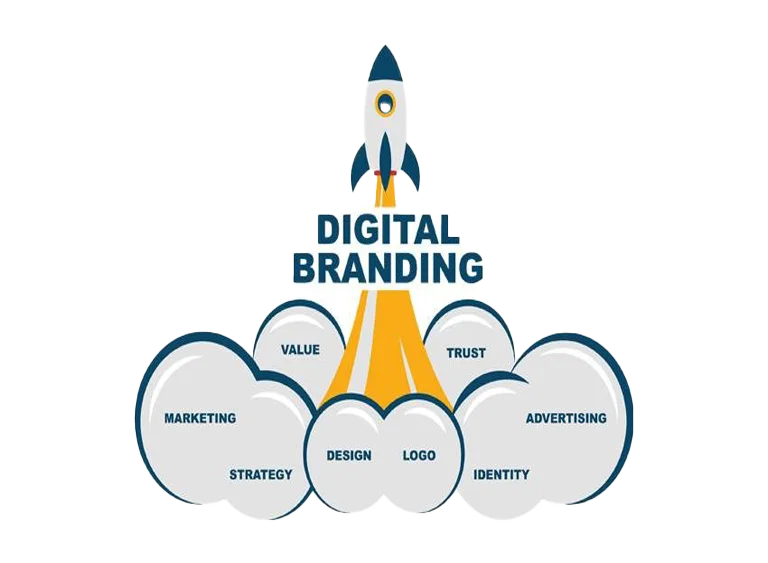New Market Landscape With Digital Branding Revolution
In the rapidly evolving world of business and marketing, one term has emerged as a driving force behind success – the “Digital Branding Revolution.” As the digital landscape continues to reshape consumer behavior and market dynamics, understanding and harnessing this revolution has become essential for businesses of all sizes. In this blog post, we will delve into the concept of the digital branding revolution, its significance, and how to navigate this exciting new marketing landscape.

What is digital branding?
Digital branding is a strategic process that involves using digital channels, technologies, and platforms to establish, build, and promote a brand’s identity, presence, and reputation in the online world. It encompasses all the online interactions and touchpoints that shape how a brand is perceived by its target audience. Digital branding aims to create a consistent and compelling online presence that resonates with customers and distinguishes a brand from its competitors.
Concepts of digital branding
Online Identity: Defining and articulating a brand’s core values, mission, and personality to create a distinct online identity. This identity should align with the brand’s overall objectives and resonate with the target audience.
Website Design: Crafting a user-friendly and visually appealing website that effectively communicates the brand’s message and provides a seamless user experience. The website serves as a central hub for digital branding efforts.
Social Media Presence: Establishing and maintaining an active presence on social media platforms that are relevant to the brand’s industry and audience. Social media channels are used for engagement, content distribution, and customer interaction.
Content Marketing: Creating and sharing valuable, relevant, and engaging content that showcases the brand’s expertise, solves customer problems, and builds trust. Content can include blog posts, videos, infographics, and more.
Visual Branding: Developing consistent visual elements such as logos, color schemes, typography, and imagery that reinforce the brand’s identity and are used consistently across all digital channels.
User Experience (UX): Ensuring that digital assets, including websites and mobile apps, provide an excellent user experience, are easy to navigate, and meet the needs of visitors.
Online Advertising: Utilizing paid digital advertising campaigns (e.g., Google Ads, social media ads) to increase brand visibility, drive traffic, and promote products or services.
Online Reputation Management: Monitoring online conversations, reviews, and feedback to maintain a positive brand reputation and address any negative sentiment or issues promptly.
Defining the Digital Branding Revolution
The Digital Branding Revolution refers to the profound transformation of branding practices and strategies in the digital age. It encompasses a shift from traditional marketing methods to a dynamic and interconnected online ecosystem where brands engage with audiences in innovative ways.
Here are key aspects of this revolution:
Online Presence is Paramount: In a world where consumers spend a significant portion of their lives online, having a strong digital presence is non-negotiable. This goes beyond a website; it includes social media profiles, content marketing, online advertising, and more.
The Power of Social Media: Social media platforms have become the epicenter of brand-consumer interactions. Brands use platforms like Facebook, Instagram, Twitter, and LinkedIn not only for promotion but also for direct engagement, feedback collection, and community building.
Content is King: High-quality, relevant, and engaging content is at the heart of digital branding. Content marketing, including blog posts, videos, infographics, and podcasts, allows brands to connect with their audience authentically.
Personalization and Customer Experience: The digital era has enabled hyper-personalization. Brands can tailor their offerings, messages, and user experiences to individual preferences, creating deeper connections with customers.
Why the Revolution Matters
The Digital Branding Revolution matters for several compelling reasons:
Global Reach: Digital platforms enable brands to reach a global audience, breaking down geographical barriers.
Data-Driven Insights: Brands can access vast amounts of data to understand customer behavior, preferences, and trends better, allowing for data-driven decision-making.
Cost-Effective Marketing: Online advertising and digital marketing techniques often offer better ROI than traditional methods, making it accessible to businesses of all sizes.
Real-Time Engagement: The digital landscape allows brands to engage with customers in real time, addressing concerns and building relationships instantly.
Navigating the Digital Branding Revolution
To thrive in the era of the Digital Branding Revolution, consider these strategies:
Define Your Brand: Clearly define your brand identity, values, and messaging. Ensure consistency across all digital touchpoints.
Content Strategy: Develop a robust content strategy that speaks to your target audience’s needs and interests. High-quality content is a cornerstone of successful digital branding.
Social Media Mastery: Understand your audience’s preferred platforms and engage authentically. Consider paid advertising for wider reach.
Data Utilization: Leverage data analytics to gain insights into customer behavior and preferences. Use these insights to refine your strategies continually.
Adapt and Innovate: Stay updated on digital marketing trends and emerging technologies. Be ready to adapt and innovate as the digital landscape evolves.
In conclusion, the Digital Branding Revolution is reshaping the way businesses connect with their audience. Embrace this revolution, adapt to its dynamics, and use it to create authentic, meaningful connections with your customers. In the digital era, your brand’s success depends on how effectively you navigate this exciting new marketing landscape.







